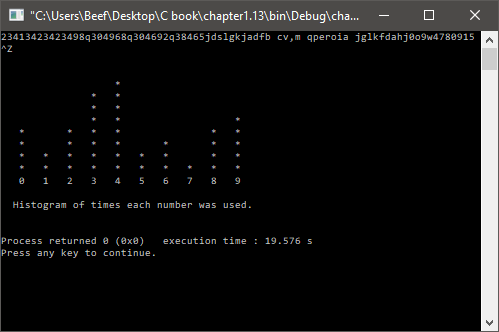Hello! I've been wanting to learn C a while now and finally decided to pick up Kernighan and Ritchie's ANSI C. One of the 'projects' is to create a numbered histogram, which I successfully did.
I just would like to know if this could be further optimized or any other pointers you all may have.
Thanks!
Here it is running:Code:/* Histogram for counting input of numbers. Troy Martin, Beef Erikson Studios 2018 */ #include <stdio.h> int main() { /* forward declares */ int c, i, j; int ndigit[10]; /* variable / array assignment */ int number = 0; for (i = 0; i < 10; ++i) ndigit[i] = 0; /* reads input and puts numbers into corresponding array index */ while ((c = getchar()) != EOF) if (c >= '0' && c <= '9') ++ndigit[c-'0']; printf("\n\n"); /* finds highest number */ for (i = 0; i < 10; ++i) if (ndigit[i] > number) number = ndigit[i]; /* display histogram based on highest number */ for (i = 0; i < number; --number) { for (j = 0; j < 10; ++j) { if (ndigit[j] >= number) printf(" *"); else printf(" "); } printf("\n"); } /* prints footer */ for (i = 0; i < 10; ++i) printf("%4d", i); printf("\n\n Histogram of times each number was used.\n\n"); }





